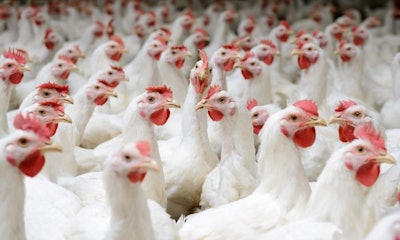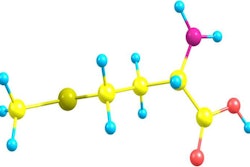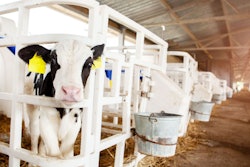
Broiler performance and genetics have driven the “big bird” market in the past decade, but climate change, welfare are poised to shape the poultry industry’s future
The history of broiler performance has evolved dramatically over the years to accommodate consumer demands and maximize profit. But do the benefits of the way we grow chickens outweigh the consequences?
A brief history of broiler performance
The average broiler today looks very different to what it looked like a few decades ago.
According to data from the National Chicken Council (NCC) and the U.S. Department of Agriculture (USDA), the earliest stats from 1925 show that the average broiler market age was 112 days with an average market weight of 2.5 pounds of liveweight, a 4.7 feed conversion ratio (FCR) and an 18% mortality rate.
By 2013, the mortality rate decreased to its lowest point — just 3.7% — with an average 47-day market age, 5.92 pounds of liveweight and a 1.88 FCR. Since 2013, however, the mortality rate has slowly risen to 5.3% in 2021 while still maintaining market weight, age and FCR efficiency.
Poultry nutritionist with the University of Arkansas, Dr. Craig Coon, points to key moments in the industry’s history that have illustrated companies’ drive to raise larger birds faster and what that means for the future of the industry.
According to Coon, 1994 was an important shift from consumers buying whole chickens to wanting cut-up broiler meat in packs. Breast meat was the ideal section of the bird to do this because it could be easily deboned and processed and had less fat than the rest of the bird.
Then, between 2000 and 2005, we see what Coon refers to as a “shift toward a big bird market” where large birds — specifically over 7.5 pounds — made up 13% of the market in 2005, whereas that percentage had been zero just five years prior.
Driven by increased consumer demand for chicken breast, poultry production companies have focused their attention over the years on FCRs and broiler genetics that not only grow birds larger and faster but also focus on breast meat yield.
The rise of woody breast syndrome
The emphasis on fast-growing, high-yield birds has led to poultry health complications that have called into question the longevity of the broiler genetic selection process. One of the most common health complications is woody breast syndrome, which causes meat stiffness, unappealing color and lower protein quality.
In a 2017 study titled, “Rapid on-line detection and grading of wooden breast myopathy in chicken fillets by near infrared spectroscopy,” woody breast syndrome had a 9% prevalence rate in a flock of 10,483 fillets. Many other studies conducted between 2015 and 2020 to find the cause of woody breast syndrome have come up with theories that revolve around how modern birds are grown.
Today’s increasing growth rates could be compromising blood circulation in Pectoralis major, resulting in muscle atrophy, reducing connective tissue and compromising arterial blood circulation that could reduce muscle cell oxygen supply. Because woody breast impacts the quality of the meat, “research directions are warranted toward genetically improving meat broiler lines that will deliver improved arterial circulation in muscle fibers to alleviate the WB [woody breast] myopathy condition.”
In other words, for the sustained future of the industry, genetics that indicate a reduced prevalence of woody breast syndrome should be considered in the genetic selection process.
The pros and cons of genetic selection
Coon’s predictions for the future of genetic selection could come with further complications.
He refers to the 2012 study, “Comparative Response of Different Broiler Genotypes to Dietary Nutrient Levels,” which points out that modern broilers have smaller organs compared with older genetics. Smaller organs like the heart, liver, kidney and gastrointestinal tract could lead to issues with improper nutrition and insufficient oxygen intake.
The broiler genetic selection process has not solely had negative consequences.
The aforementioned study also talks about increased intestinal villi length that has improved nutrient absorption as well as increased bone density to support the larger birds. With the broiler genetically evolving, some standard practices should be adapted to properly accommodate the bird of the future.
How climate change impacts poultry welfare
As poultry genetics change, producers should be realistic when it comes to the poultry feeding and housing infrastructure. With birds growing ever-larger, some key elements of poultry housing should be taken into consideration, Coon says, such as increased space, lower stocking density and more feeder space.
Larger birds simply need more space to get adequate nutrition and dissipate heat easier, especially with rising temperatures caused by climate change.
“Higher environmental temperatures that have become more common can be deadly for large broilers ready for market,” Coon said. However, “I think the industry may be at a crossroad.”
Larger birds provide higher profit for producers, but meeting the needs of larger birds will cut into that profit.
Environmental footprint of broiler production
While the benefits of broiler genetic selection and feed efficiency extend beyond increased profits, a growing emphasis on reducing the environmental footprint of poultry production will likely take center stage in the decade ahead — giving fast-growing birds an advantage.
For example, faster-growing broilers also require less overall energy to raise, which will have a positive impact on energy usage; and increased meat yield will help to meet the protein demands of a global population topping 9 billion by 2050.
In addition, optimized feed efficiency, especially from non-plant-derived sources, can help reduce the poultry industry’s carbon footprint.
With all of these factors weighing in, what will our chickens look like 10 years from now?
Editor’s note: Information is acquired from Review: Physiological growth trend of current meat broilers and dietary protein and energy management approaches for sustainable broiler production from the University of Arkansas’ Department of Poultry Science.
To see how the broiler industry evolved from 2001-11, read, “Poultry performance improves over past decades” from the archive.















